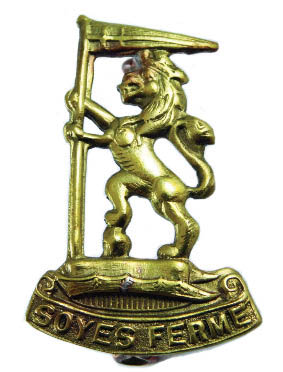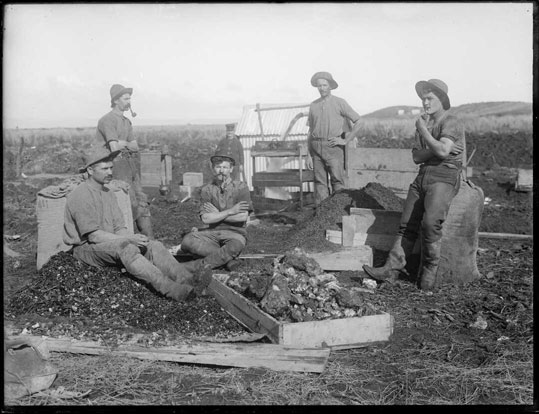The Cap badge of the 4th Battalion, 3rd New 
Zealand Rifle Brigade with whom
Charles Richardson served.
Charles Samuel Richardson was born in Melton in 1871 and was baptised in St Andrews Church on 26th December that year. By 1891, the nineteen-year-old Charles had left home and was working as a groom in Paddington, London — but this was not to last for long. Charles soon emigrated to New Zealand to begin a new life, arriving in Wellington after a three month journey under sail. Charles travelled to Parua Bay on North Island, New Zealand, to live and work as a gum picker.
Gum pickers were men and women who dug for kauri gum, a fossilised resin used in varnishes. The work was demanding, the pay poor, and often carried out by farmers as a means of supplementing their income during the winter months. In 1898, the Kauri Gum Industry Act was passed by the New Zealand Government, reserving the fields for British subjects and requiring all other diggers to be licensed. By 1910, only British subjects could hold gum digging licences.
Charles Richardson was a gum digger on the North Island of New Zealand. The work was hard 
and paid little. The gum can be seen in the foreground of this picture.
(Northwood, Arthur James, 1880-1949)
Ref: 1/1-011236-G. Alexander Turnbull Library, Wellington, New Zealand. /records/22719966
On 23rd October 1915, Charles made his way to Whangarei to enlist, providing entirely false information; he dropped three years from his age, changed his place of birth to Rugby, Warwickshire and listed a neighbour in Parua Bay as his next of kin. It appears that he had severed all ties with his family back in Melton.
After a period of training, Charles and the 3rd Reserve Company were posted to France. They left Wellington on 1st April 1916, arriving in Egypt a month later where they remained for three weeks. After which, they continued to France and encamped at Etaples on 28th May. Here, the men underwent further training and Charles was posted to “A” Company of the 4th Battalion, 3rd New Zealand Rifles on 9th August 1916 — they were based on the Somme. The battalion had previously served in Gallipoli but were evacuated the previous December. This was their first time back on the front line.
On September 15th, Charles and the battalion took part in the capture of Flers, where tanks were used for the first time. They took part in a further three assaults during the battle before being withdrawn and sent north, to Flanders. In 1917, the New Zealand Division took part in the Battle of Messines, a precursor to the Third Battle of Ypres. The Messines assault on 7th June 1917 was an outstanding success: Charles and his battalion achieving all of their objectives with few casualties on the day and they were ordered to dig in to consolidate the line. Over the next two days, the German artillery began to fire on the newly-captured ground with increasing ferocity and, by the time the New Zealanders were relieved, they had suffered three thousand seven hundred casualties, including seven hundred dead.
On 4th October, the 4th Battalion was back in action in the Battle Of Broodsneide. They achieved their objective of the Gravenstafel Ridge, despite the mud, which was described by the New Zealand Divisional Commander, Sir Andrew Russell as “being a worse enemy than the Germans”. Eight days later, Charles was back in action in the First Battle of Passchendaele. The New Zealand Division was to capture Bellevue Ridge in support of the Australians who were to take Passchendaele. The attack started on 12th October and was a disaster for both the New Zealand Division and the Australians. No real progress could be made due to the German army’s location on Bellevue Spur, which meant they were able to cover both advances with enfilade fire.
The 12th of October was to become known as the “Blackest Day” in the New Zealand Army's history. Again, over three thousand seven hundred men were casualties with a death toll in a single day of nine hundred and fifty. Charles was one of those killed in action on that day. His body was recovered: identified by his dog tags and a letter in his pocket. Charles is buried at Tyne Cot Cemetery.
For his war service, Charles received the British War and Victory Medals which were sent to his mother, Sarah, in Melton.
